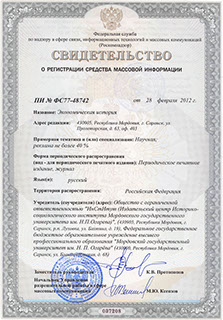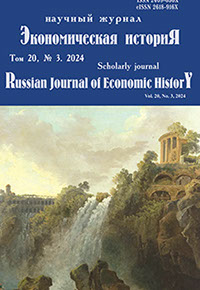Экономическая историЯ
Russian Journal of Economic History
ISSN 2409-630X (Print)
ISSN 2618-916X (Online)
Expert board:
- Scientific Council of RAS on economic history;
- Research and Educational Center «The economic history of Central Russia and the Middle Volga region» of Ogarev Mordovia State University;
- Center of Economic History of Lomonosov Moscow State University
Navigation
Certificate of registration

УДК 94:338.45
Nikolay M. Arsentyev
National Research Ogarev Mordovia State University,Saransk, Russia,
е-mail: director_isi@bk.ru
Russian Metallurgical Industry of the late XVIII – First Half of the XIX Century in the Global Dimension of Industrialization
Abstract
Introduction. One of the topical problems of Russian industrial history is still the determination of its place in the global dimension of industrialization. In particular, this article analyzes, using the history of metallurgical production as an example, the question of the state and the missed opportunities of the domestic industrial development of the late XVIII – first half of the XIX century. As it is known, at the beginning of this period the country was growing new lands, developing socio-economically and culturally, and in the world production of ferrous metals, the leading branch of the economy, which determined the country’s place in the world GDP, even led. Russia was able to meet the needs of Europe in cheap and high-quality metal, which accelerated the formation of industrial societies there, primarily in England. However, by the mid-19th century, Russia’s economic development was industrially dependent on Western technologies, and its international position deteriorated significantly due to the defeat in the Crimean War of 1853–1856.
Materials and Methods. The dynamics of the internal and external sphere of emerging industrial societies has always been mobile and diverse. The modern community of researchers in analyzing these processes has to operate with the conceptual apparatus of different generations of historians studying this problem. Historians studying the topic from the perspective of the formation dimension of the past social reality, analyzed the models of industrial development (craft, manufactory, factory) in the context of the formation of capitalist relations and the beginning of the industrial revolution. From the civilizational approach, the process of industrialization was usually associated with country specificity, based on traditions and continuity in development. In the world-system approach it is accepted to speak about the formation of capitalist world-economy in accordance with which, abstracting from the multiplicity of characteristics of socio-economic development of individual countries, the center, semi-periphery and periphery were traditionally distinguished. Russia, together with China, was categorized as a semi-periphery. According to F. Brodel, one of the founders of this theory, up to the Crimean War of 1853–1856, Russia maintained its own world-economy. Russia maintained its own world-economy with its periphery inside the country. In modernization theory, focused primarily on the analysis of the transition from agrarian society to industrial society, this period was associated with the processes of proto-industrialization and early industrialization. Russia belonged to the countries of the second echelon of modernization, which, in order to catch up with the West must constantly reform the country to European standards. What is common in these approaches to the analysis of the past social reality is the recognition of the periodic change of priorities of industrial development depending on the meanings of domestic and foreign policy. The emergence of a new technogenic environment based on modern technological modes, new techniques and technologies, changed the socio-economic foundations of society, led to the transformation of institutions of power, the way of life of the population, etc. The new model of society, some call it industrial, others – capitalist, others – modern world-economy, but in all existing dimensions of the historical process it was characterized by a pronounced hierarchy of dependencies. In terms of the pace and level of development in the context of various paradigms, the world was divided either into different echelons of modernization (leaders and catch-up), or into countries with capitalist and Asian modes of production, or into central states (core), semi-peripheral and peripheral zones. In addition to the analysis of the research laboratory, I would also note that when analyzing the past social reality, the traditional principles of historicism, objectivity, and systematicity allowed us to fully, deeply and comprehensively consider the topic under study.
Discussion and Conclusion. Each historical epoch is characterized by the existence of a large number of countries with different levels of socio-economic development and military, political and cultural influence. Some countries are in some ways on the leading edge of progress, while others, relying on their own resources, are building their own trajectory in accordance with the new challenges and threats of history. Attempts to distinguish the center, semi-periphery and periphery, as well as to divide the countries into the first, second, third echelon of modernization, or to reproduce other different hierarchies of the level of dependence, do not reflect the nature and diversity in the development of a constantly reproducing multipolar world. The result of such manipulations most often becomes only leveling and schematization of historical processes in the context of this or that theory. The new reality that emerged, including in Russia, in the late 18th - first half of the 19th century, associated with the development of industry and the formation of industrial society, cannot be analyzed only within the framework of a single country, since the modes of production were interconnected and spread throughout the world. The driving forces of the industrialization process were diverse. All countries tried to develop industry based on their own traditions of economic development. Industrial society was originally not a universal world system, but consisted of varieties of socio-economic patterns, national designs of economies of different countries. It is generally believed that the successful development of machine production in Europe was primarily due to the rooted traditions of private property and market relations. Russia of this time also became a part of the emerging industrial societies. In the second half of XVIII century it was even the leader of industrial development, but its success in this direction was determined primarily by state support, the system of feudal and serfdom relations and the use of the external market for the industrial breakthrough. The models of evolution of agrarian society into industrial society are diverse, long in time and not universal. “Industrial Revolution” in modern historiography is only a symbol of a long process emphasizing the revolutionary nature of the transition from agrarian society to industrial society. Russia, having in the last third of the 18th century a powerful industrial potential, in the first half of the 19th century used it inefficiently. The creation of industrial society took decades, which is explained primarily by the dominance of autocratic and landlord ideology in the formation of industrial policy in the period under study. Only the defeat in the Crimean War showed the vulnerability of Russia in competition with industrialized countries and the processes of industrial development of the country were activated again.
Keywords: Industrial Revolution, iron trade with England, Russian industrialization, industrial society, metallurgical production of Russia at the end of XVIII – first half of XIX century, mining districts.
For citation: Arsentyev N. M. Russian Metallurgical Industry of the late XVIII - First Half of the XIX Century in the Global Dimension of Industrialization. Economicheskaya istoriya = Russian Journal of Economic History. 2024; 20(3): 217–231. (In Russ.).
© Ogarev Mordovia State University. History and Sociology Institute, 2017
68, Of. 411, Bolshevistskaya St., 430005, The editorial office of the scholarly journal «Russian Journal of Economic History»
Tel.: (8342) 24-25-90; 27-07-11, Fax: (8342) 24-25-90, E-mail: jurnal-econom-hist@isi.mrsu.ru
Designed by A. Napalkov, Email: napalkov@isi.mrsu.ru

